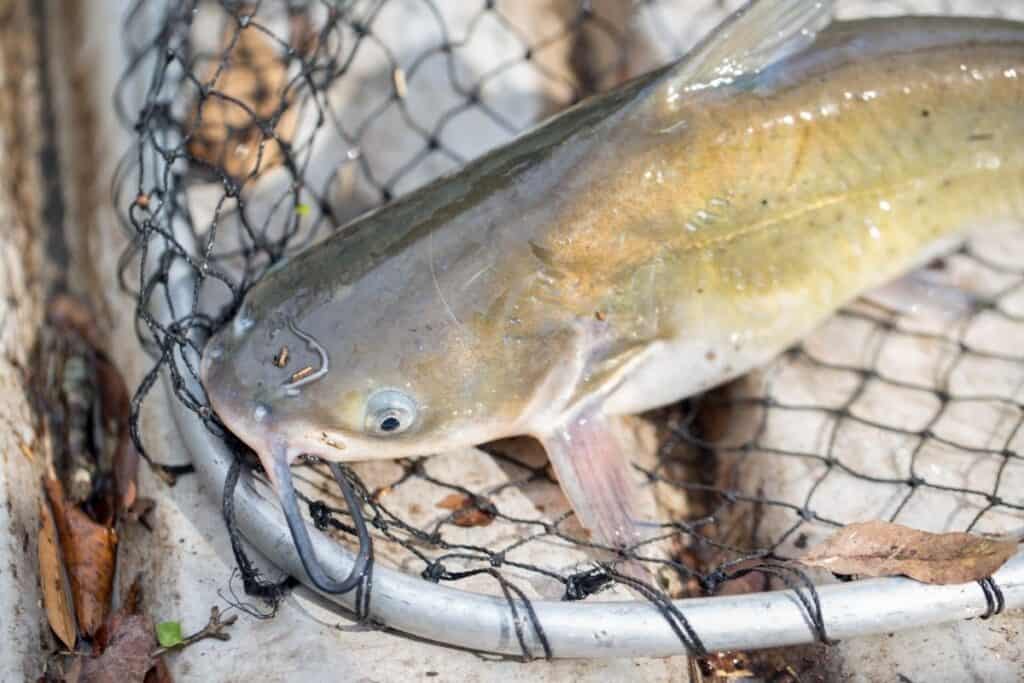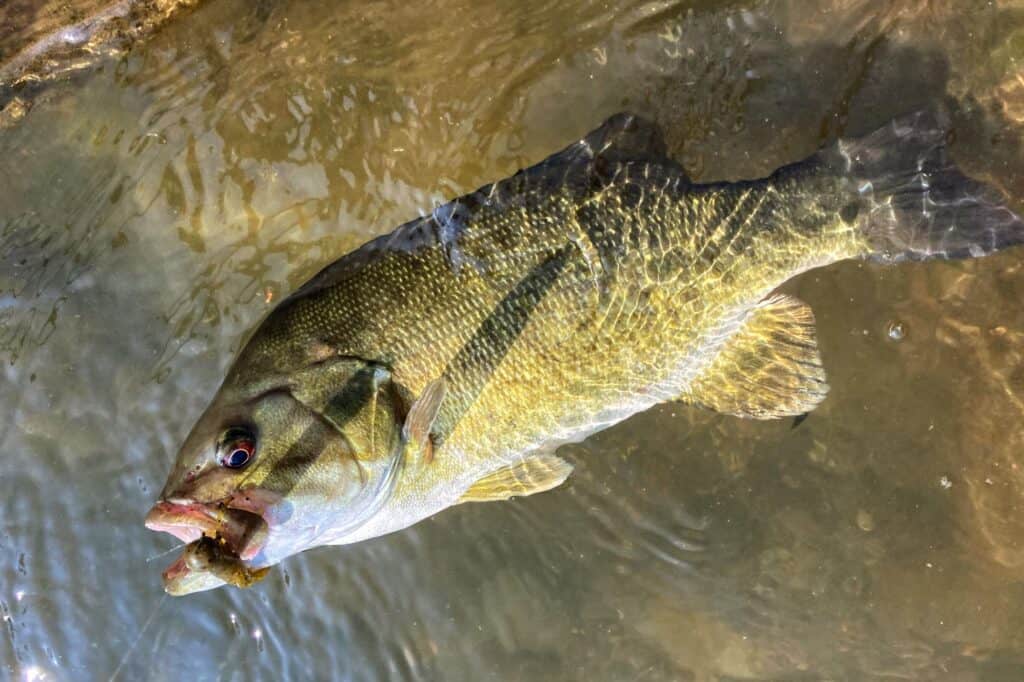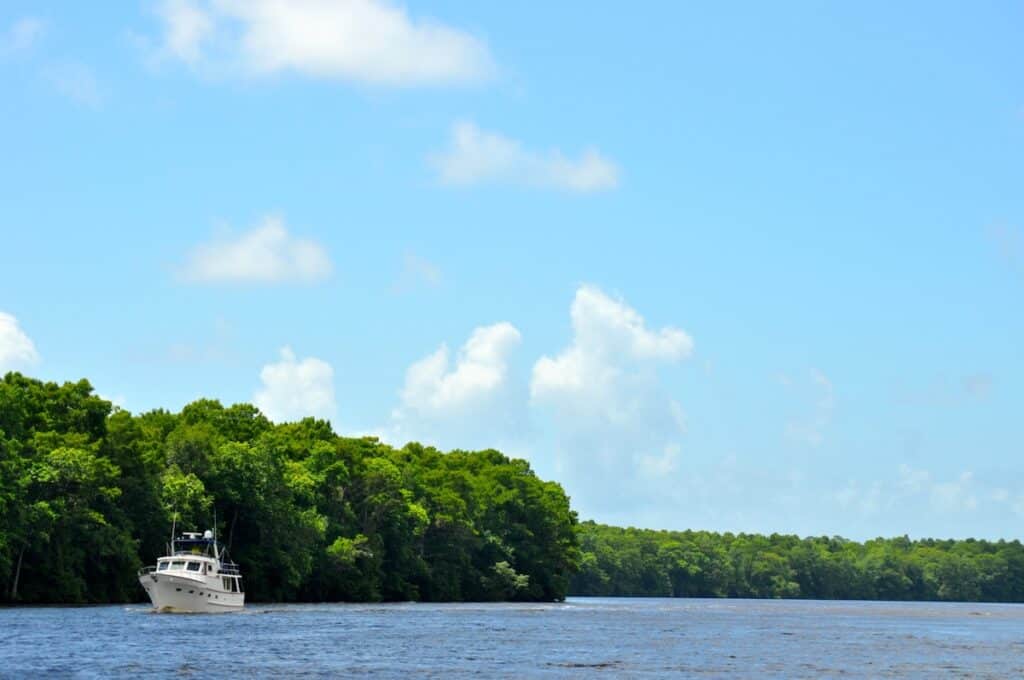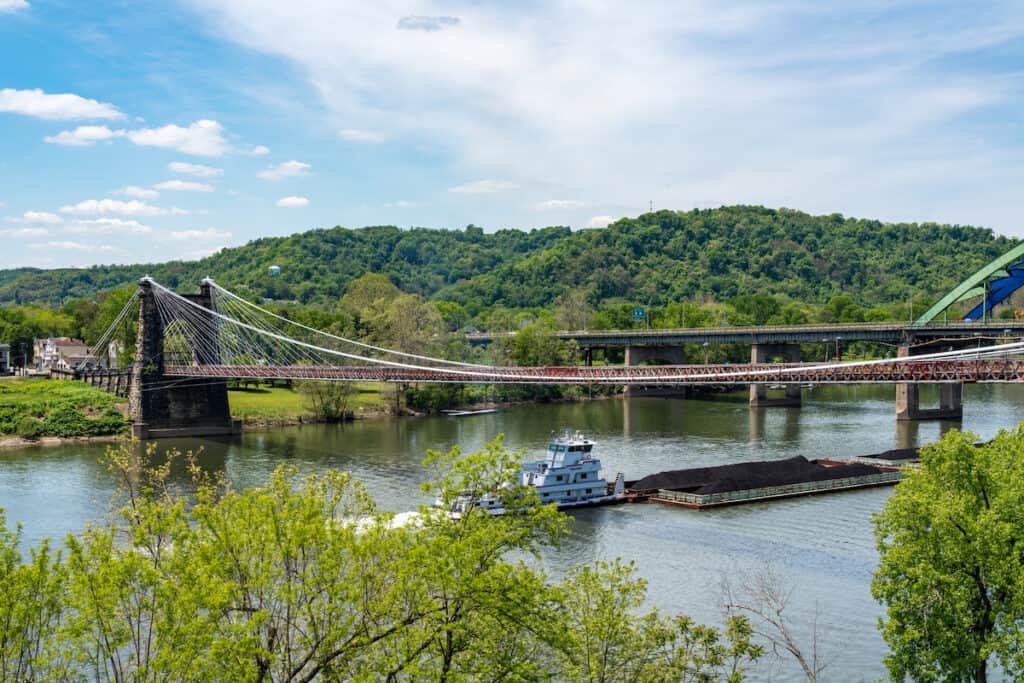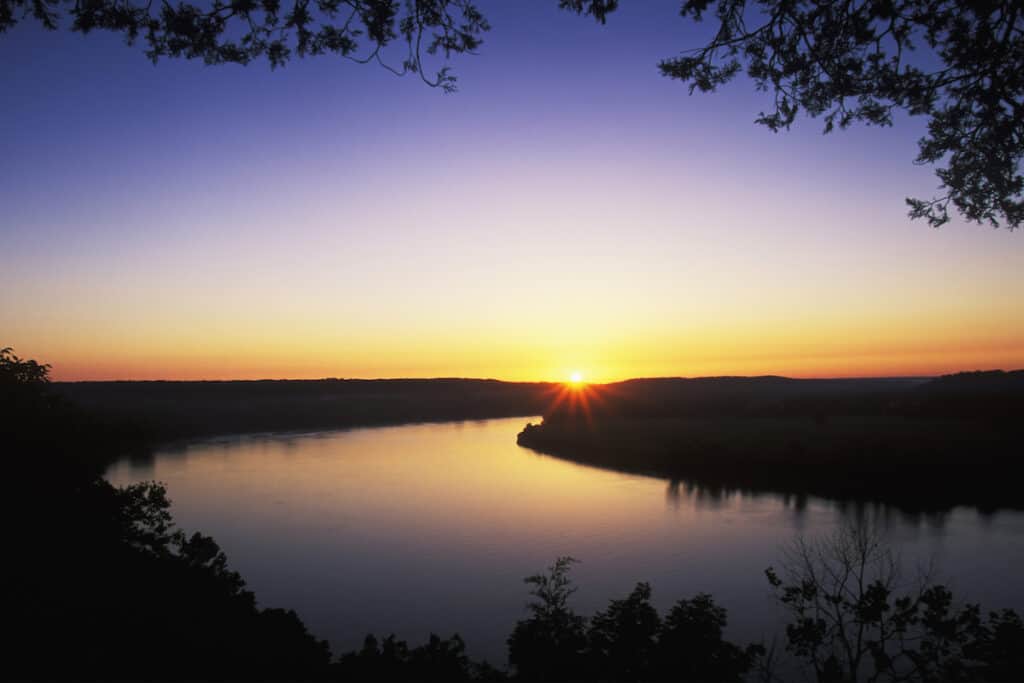Editor’s Note: This complete angler’s guide will show you exactly where, when and how to catch the Ohio River’s top gamefish. Use the table of contents to zero in on your favorite species and fishing location.
With a watershed that drains portions of 11 states—including the six states it touches—the Ohio River is a massive waterway that provides phenomenal fishing opportunities.
From its origin in Pennsylvania to its confluence with the Mississippi River, the Ohio River stretches a total of 981 miles. It’s a river that can test anyone’s angling skills, but persistence here can unlock some of America’s best fishing.
The river is generally considered the boundary between the South and the Midwest. Though major cities, including Pittsburgh, Cincinnati and Louisville, overlook its banks, much of the river is extremely rural and undeveloped, allowing anglers plenty of opportunities to get away from the crowds.
A series of locks and dams break the Ohio River into navigational pools, each offering swift tailwaters at the upper end and still, almost lake-like conditions at the lower. It takes a lifetime to fully explore even one of the Ohio River’s pools, let alone the entire river.
Game Fish of the Ohio River
Channel Catfish
Some of the most frequently-caught fish in the Ohio River, channel catfish are abundant throughout each of the river’s pools. They’re prized as table fare, and channel cats weighing 2 to 5 pounds are ideal for eating.
Channel catfish are also capable of reaching much greater sizes, and it’s not uncommon to catch individuals weighing 15 pounds or more. They’re frequently caught from the bank, making them some of the most accessible fish for shore-bound anglers.
Natural baits, including nightcrawlers, crayfish, chicken livers and shrimp, are the best channel cat baits, along with minnows, which anglers fish either alive or dead as cut bait. Keeping your bait near the bottom is key to success, and doing so in the Ohio River often requires a hefty sinker.
Fishing for channel catfish is best from May through July, though they bite well any time water temperatures are over 50 degrees. Fishing is often best at night, but channel catfish also feed actively during the day in the Ohio’s often-muddy waters.
Tailwater areas below dams are some of the most productive spots for channel cats, as well as areas around tributary mouths. Rocky areas, sand bars, wing dams, riprap shorelines, and artificial structures like barges and piers are also productive.
Catch More Catfish
Find the best catfishing in Illinois, Indiana, Ohio and Pennsylvania (other states in progress).
Catch more of them with our easy guide to catfish fishing techniques, baits and tackle.
Flathead Catfish
Commonly weighing 20 pounds and capable of reaching over 50, flathead catfish are some of the Ohio River’s most fearsome predators. They inhabit areas all along the length of the river, but are less common at the upper end.
Identifiable by their olive-brown coloration and flattened heads—they’re commonly called shovelheads—flathead catfish are less inclined to scavenge than other catfish species. They’re active hunters that strike live baitfish, including bluegill, shad and small carp.
Nose-hooking live bait on a circle hook is the technique of choice. Anglers typically affix an egg sinker or flat no-roll sinker to the line 16 to 24 inches above the hook.
Flatheads favor the thickest, snaggiest cover they can find during daylight hours, emerging from deep holes to feed at night. The best time to catch flatheads is from sundown until a few hours after dark.
Good fishing is often found at bends in the river and downstream from creek mouths, where the current usually forms deep holes and gravel bars.
The period from March until flatheads spawn in May offers excellent fishing, and summer can also be productive.
Blue Catfish
Blue catfish are the giants of the Ohio River. These fish are capable of reaching over 100 pounds, and world record-class blue cats have been produced in the Ohio River, as well as state records in most of the states the river touches.
Blue cats weighing 25 pounds are quite common, though this species is less abundant overall than either channel cats or flatheads. The most effective technique is controlled drifting a large cut bait, with skipjack herring being the top choice.
Most big blue cats are caught in the lower Ohio River below the Cincinnati area. That being said, some quality fish are caught farther up the river, and efforts are being made to introduce them all the way up to Pittsburgh.
Large, solitary predators, blue catfish prowl deep water and usually bite well in the early morning and late evening hours. Good places to catch them include ledges, drop-offs, and current seams in 25 to 35 feet of water.
Smallmouth Bass
The Ohio River offers truly excellent bass fishing, with smallmouths being the more common black bass species in most of the river.
Smallmouth bass weighing 2 or 3 pounds are abundant, and many pools of the river produce trophy smallmouths.
The best smallmouth fishing is generally in the upper Ohio River, from Pittsburgh down to the Willow Island Lock & Dam between Ohio and West Virginia. However, there isn’t a single mile of the river that doesn’t have potential.
Smallmouth bass thrive in rocky habitat, and identifying rocky cover is essential to finding them. Gravel bars and riprap banks are key areas. Smallmouths often gravitate to current breaks such as wing dams, islands, bridge pilings and piers.
Tailwaters below each of the Ohio River’s dams provide some of the best smallmouth bass fishing.
Crayfish are the top food source for smallmouth bass, followed by shad and various other baitfish. Fishing is excellent throughout the warmer months, but especially in spring.
Tube jigs, crankbaits and jerkbaits are among the most effective lures, along with spinners when the water is especially turbid.
Many Ohio River anglers favor live bait, and smallmouths are reliably caught in tailwaters using live shiners.
Catch More Bass
Find the best bass fishing spots in Illinois, Indiana, Ohio and Pennsylvania (and soon other states).
Pick up some top tactics in our simple how-to guide to bass fishing.
Largemouth Bass
Anglers can also take advantage of excellent largemouth bass fishing in the Ohio River. Trophy largemouths are rare, but 2- and 3-pound bass are common in many Ohio River pools.
Largemouth bass fishing is best in the middle and lower Ohio River, where the gradient is lower than in the upper part of the river, resulting in slower current. Largemouth bass favor slack current and backwater areas, and they have many great options here.
In spring, the best fishing is in creeks, bayous and embayments along the river. Bass seek out these areas to spawn, and anglers can take advantage of great shallow-water bass fishing in April and May using plastic worms, crankbaits and spinnerbaits.
As the river warms up from June onward, the best bass bite is usually a little deeper. Summer and early fall are the best times to fish the main river, whereas early spring and late fall tend to be better in tributaries and backwaters.
Fallen trees, sunken timber and brush are all key pieces of cover that attract largemouths.
Many areas just above dams also develop abundant weed beds, which can also be very productive.
Try deep holes at the mouths of creeks in summer using jigs and diving crankbaits.
Walleye & Sauger
The Ohio River supports ample populations of both walleye and sauger. Though they are two separate species, walleye and sauger are closely related and are often caught in similar areas using the same techniques.
Both species bite best when the water is cold. This tendency is especially true of sauger, which outnumber walleye in the Ohio River and often offer excellent fishing in the dead of winter.
Tailwaters below the dams are the most reliable spots, and fishing is best when the water is under 50 degrees.
Sauger and walleye congregate in tailwater areas in early spring and disperse throughout deeper parts of the river in summer, only to return again in late fall.
The bait of choice is a 1/8 to 3/8-ounce jig tipped with a brightly colored soft plastic trailer, such as a curlytail grub or a shad-style swimbait. Add a live minnow for even more attraction, especially if you’re fishing with a slow presentation.
Keeping your bait near the bottom is important.
Walleye and sauger fishing can be good day or night, but night fishing is often better.
Walleye are the larger of the two species, and the Ohio River commonly produces walleye over 5 pounds.
Catch More Walleye
We’ve compiled guides to the best walleye fishing in Illinois, Indiana, Ohio and Pennsylvania.
Catch more of these delicious fish by learning the top walleye fishing techniques, tackle and other tips.
White Bass
Though many anglers overlook them, white bass are some of the most abundant fish in the Ohio River. They are frequently caught, though they are seldom the primary target.
White bass typically measure 9 to 12 inches (though individuals up to 20 inches are possible) and readily strike live baitfish and small minnow-imitating lures. Blade baits, spinners, spoons, jerkbaits and various minnow-imitating soft plastics are effective.
Tailwaters often attract white bass. Huge schools of these fish also roam open pools following pods of shad or stack up along drop-offs and ledges.
White bass also go on an epic spawning run in early May as soon as the water temperature climbs into the 50s, migrating up tributaries all along the Ohio.
This is the most popular time to fish for white bass, and 100-fish days are possible when the spring spawning run is in full swing.
Catch More White Bass
Striped Bass & Hybrid Striped Bass
Striped bass, though not native to the Ohio River, are members of the temperate bass (or “true bass”) family like white bass and have been stocked in many pools.
Stripers are capable of topping 50 pounds, though they seldom grow past 25 pounds in the Ohio River.
In spring, stripers head upriver and gather below many of the Ohio River’s dams. They’re easy targets this time of year on live shad, jigs and blade baits.
Stripers spread out in summer, and some anglers troll main river drop-offs using umbrella rigs.
Hybrid striped bass, hatchery-raised crosses between white and striped bass, have also been stocked by state agencies in Ohio, Kentucky, West Virginia and Pennsylvania.
Hybrids behave much the same as stripers and are intermediate in size between their parent species.
Hybrid stripers have become more common than true stripers in the Ohio River. April and May are prime months.
Both hybrids and stripers are known to hold just outside the fast-moving water below dams, waiting for disoriented baitfish to be swept by in the current.
Crappie & Panfish
Crappies are another species anglers too often overlook in the Ohio River, but substantial populations of both black and white crappies are available for anglers who care to target them.
Some of the best crappie fishing is along the Kentucky portion of the river.
Spring is the best time for crappie fishing, and sheltered backwaters offer much better fishing than the main river.
Crappies don’t like strong currents, and they also seek out the warmest available water in early spring. They often congregate in backwaters as early as February.
Crappie fishing is usually excellent through May. Focus on shallow, woody cover like flooded brush and timber along the riverbanks.
A small jig or live minnow below a float is the best bait, and many anglers spider-rig for crappies with up to eight rods.
Bluegill and sunfish are also common throughout shallow, relatively slack portions of the Ohio River.
These panfish are abundant but not known for their size. Still, they’re easy pickings with live red worms on summer days when other species are reluctant to bite.
Catch More Crappie and Panfish
Find the top crappie fishing spots in Illinois, Indiana, Ohio and Pennsylvania (more states are being added as you read this).
Crappie Fishing: Simple How-To Techniques and Tips
Bluegill and Sunfish Fishing: Simple How-To Techniques and Tips
Ohio River Fishing Guide
The Ohio River provides a major fishing resource in each of the six states it touches, though the upper Ohio is quite different from lower portions of the river in both size and type of habitat.
The following sections will explore some of the best places to fish the river in each state.
In addition to dividing up the Ohio River by state, it can also be helpful to break up the river into pools. A total of 21 locks and dams split the Ohio River into as many navigation pools. Each pool is unique and takes its name from the dam at its lower end.
Many areas offer excellent mixed-bag fishing. Tailrace areas, in particular, are known for attracting a wide range of game fish, and one truly never knows what they’ll catch when they toss a live minnow below one of the Ohio River’s dams.
In every pool of the Ohio River, the tailrace at the upper end is likely to be one of the best spots. Use caution, as swift water and unpredictable currents can also make tailwater areas some of the most dangerous places on the river.
Pennsylvania
The Ohio River begins in Pittsburgh at the confluence of the Allegheny and Monongahela rivers.
Point State Park is a popular urban bank fishing spot right at the very start of the river, and anglers catch lots of channel cats, smallmouths, walleye, sauger and hybrid stripers here.
The first pool of the river stretches just 6.2 miles down to the Emsworth Dam, and the second pool is a further 7.1 miles to the Dashields Dam. Key areas include Brunot Island and the Emsworth Dam tailwater. Pittsburgh’s many bridges are all worth a cast or two as well.
The Montgomery Pool, which is 18 miles in length beginning below the Dashields Dam, is where the fishing starts to really get good. The river leaves the urban landscape behind at this point, and the Montgomery Pool is known for producing some very nice walleye.
In addition to the Dashields Dam Tailwater, the mouth of the Beaver River is a good spot on the Montgomery Pool. Rochester Riverfront Park and the nearby Rochester Boat Ramp provide access, and there’s a lot of good rocky and woody cover in the river.
The Montgomery Dam is the final dam in Pennsylvania. It marks the beginning of the New Cumberland Pool, which stretches close to 23 miles and extends from Pennsylvania into Ohio and West Virginia.
Ohio/West Virginia
Starting with the New Cumberland Pool—which is known as one of the most scenic pools on the Ohio River—the Ohio River forms the 277-mile state line between Ohio and West Virginia.
This stretch offers abundant rocky habitat and provides the river’s best smallmouth bass fishing.
The New Cumberland Pool features several islands that provide excellent bass fishing at both their head and tail ends: Babbs Island, Baker Island and Cluster Islands. Yellow Creek is a major tributary on the Ohio side with excellent multispecies fishing.
Chester City Park in Chester, WV, is a good bank and boat access site on the New Cumberland Pool. There is also bank fishing access at the New Cumberland Lock & Dam, both above the dam and in the Pike Island Pool below.
The Pike Island Pool offers some solid flathead catfish fishing, along with other species typical of the upper Ohio, including smallmouth bass, walleye, sauger and white bass.
An abundance of rocks and riprap make the New Cumberland Dam tailrace an excellent spot. Farther down the Pike Island Pool, numerous small tributaries feed the Ohio River, and the mouths of each one offer good potential.
Boat launching on the Pike Island Pool is available in Toronto, OH, and Wellsburg, WV. There are several islands worth fishing in this pool as well, most notably Browns Island.
The next stretch is the Hannibal Pool. Excellent access is available at the head of the pool below the Pike Island Dam on the Ohio side. Other good spots in the Hannibal Pool include the Sister Islands, Wheeling Creek and Fish Creek Island.
The city of Wheeling, WV, overlooks the Hannibal Pool, making it one of the most popular pools on the upper part of the river. There’s also plenty of access, including along Wheeling’s riverfront Heritage Trail.
There is very good bank access on both sides of the Hannibal Dam, the tailwaters of which mark the beginning of the Willow Island Pool. This pool offers excellent fishing for bass and catfish around its numerous islands and ledges.
Continuing downriver, the tailrace below the Willow Island Dam is known for offering some of the best sauger fishing in the river. This area is best accessed from the West Virginia side.
The Belleville Pool has fewer islands and tributaries than some other pools, but the deep hole at the mouth of the Muskingum River is known for trophy flathead.
Weed beds at the lower end of the pool, just above the Belleville Dam, are good for largemouths.
There are multiple boat launch sites on the Belleville Pool and on the Racine Pool—the next pool below the Belleville Dam—though this section is extremely rural.
The Belleville Dam tailrace is great for sauger and white bass, and the Old Lock and Dam #21 is a prime catfish spot.
The following two pools are the Robert C. Byrd Pool and the Greenup Pool, neither of which are known for being the best on the river. Still, the tailrace areas in each pool can be productive for multiple species.
Old Lock and Dam #25 is another potential spot for catfish on the Robert C. Byrd Pool, and barges and other artificial structures in the Huntington, WV, area are always worth fishing.
Harris Riverfront Park in Huntington provides boat ramps and ample bank access.
Ohio/Kentucky

The Greenup Pool spans the state line between Kentucky and West Virginia, making the Greenup Lock & Dam the first dam on the river to straddle Ohio and Kentucky. The tailrace below the dam is excellent for sauger and white bass.
The Meldahl Pool extends 95 miles from the Greenup Dam down to the Meldahl Dam, offering truly excellent fishing. Several old locks and dams in this pool are great for catfish.
This section is also one of the best for largemouth bass, with Brush Creek being a prime bass spot on the Ohio side.
The area around Manchester Islands 1 and 2 offers excellent multispecies fishing, with an abundance of stumps and timber.
Cabin Creek, a little farther down on the Kentucky side, is great for bass, crappie, stripers and hybrids at various times.
Some of the best boat ramps on the Meldahl Pool are in Aberdeen, OH, and Mayville, KY, almost directly across from each other.
Eagle Creek and White Oak Creek are productive fishing areas on the Ohio side.
The next pool on the river is the Markland Pool, which is just over 96 miles long and flows from the Meldahl Dam tailrace down to the Markland Lock & Dam. Cincinnati overlooks this pool, and a significant portion is highly industrialized.
The Markland Pool is notable for being the first pool to offer significant blue catfish opportunities. For anglers from Ohio, this area is your best bet for big blues.
The Meldahl Dam tailrace at the upper end of the Markland Pool is a great year-round fishing spot for sauger, catfish, striped bass and hybrid stripers, as well as some nice smallmouths.
There’s excellent public access on either side of the river below the dam.
The power plant in Moscow, OH, and the marina area in New Richmond, OH, can produce quality largemouths, and any place where you see barges tied up should be considered a target.
The Markland Pool also provides great catfishing at the Old Lock and Dam #35 and various tributary mouths.
The Cincinnati waterfront features an abundance of piers, barges, bulkheads, bridge pilings, and other manmade structures that commonly produce stripers and catfish.
Cincinnati provides a lot of public access and city boat ramps, as do Newport and Covington, KY, right across the river.
Indiana/Kentucky
The Great Miami River empties into the Ohio River right at the Ohio/Indiana state line, and the Markland Pool continues for a further 40 miles to the Markland Dam.
Numerous small creeks feed the river throughout this stretch. Tanner’s Creek is arguably the best, especially for catfish.
The Markland Dam tailrace marks the beginning of the McAlpine Pool and offers great sauger, catfish and hybrid striper fishing. Markland Dam Park provides prime bank access on the Indiana side.
Excellent launch facilities are available a little farther down the McAlpine Pool in Carrollton, KY.
The nearby confluence of the Kentucky River is great for bass and catfish and is also one of the river’s better spring crappie spots. There’s a lot of wood and brush in the area.
The McAlpine Pool is fed by hundreds of small ditches and creeks, many of them unnamed, but all have the potential to hold a few fish.
Fourteen Mile Creek is a larger tributary known for bass, and the area known as the Grassy Flats around Mile Marker 586 can be great in spring.
The McAlpine Lock & Dam spans the river between Louisville, KY, and Clarksville, IN, and there’s a lot of great fishing in this area.
Falls of the Ohio State Park is just one of many outstanding access points between the two cities.
Below the McAlpine Dam, the Cannelton Pool is known for both largemouth bass and flathead catfish. Prime spots include Salt River, Old Lock And Dam #43, Mosquito Creek, and Otter Creek.
The Newburgh Pool, beginning at the tailrace below the dam at Cannelton, offers many great options, including the tailrace, which produces trophy flatheads, abundant channel cats and some bass.
A lot of the best fishing in the Newburgh Pool takes place around artificial structure, which there’s a lot of in the Rockport, IN, and Owensburg, KY, areas. Places where grain is loaded onto barges always attract catfish.
The same is true of the John T. Myers Pool, the next pool below the Newburgh Lock & Dam, which includes a lot of productive structure, especially around Evansville, IN.
The Green River, on the Kentucky side, is a great tributary on this pool.
Illinois/Kentucky
The John T. Myers Dam is within spitting distance of the Illinois State Line and represents the start of the Smithland Pool, one of the best pools on the river for largemouth bass.
The Wabash River is a major tributary that enters the Ohio just below the dam.
Key areas in the Smithland Pool for bass include Sturgeon Island, Cave In Rock Island and Stewarts Island. Old Lock And Dam #50 and Rondeau Island are known for both bass and flathead catfish.
Good access is available at Illinois’ Cave In Rock State Park.
Shallow areas of the Smithland Pool are filled with brush, ditches, cypress trees, stumps and laydowns.
These areas above the Smithland Dam are often referred to as “The Bayous.” They produce some of the best crappie fishing on the river, as well as largemouth bass.
The final two Ohio River pools, known simply as the Dam #52 Pool and the Dam #53 Pool, could be described as the least remarkable pools on the river. These pools are deep, broad, flat and rather featureless compared to the rest of the river.
That’s not to say there aren’t quality fish here. Some of the best catfish and striper fishing is in large tributaries, including the Cumberland River and the Tennessee River.
Barges and other artificial structures, especially around Paducah, KY, are the best bets, and anglers land some monster flathead catfish in this area. The Paducah city boat ramps are excellent.
The final dam on the Ohio River is the Olmsted Lock & Dam, which was completed in 2018. Launch ramps are located just below the dam on the Illinois side, and there are often some big catfish in this area.


